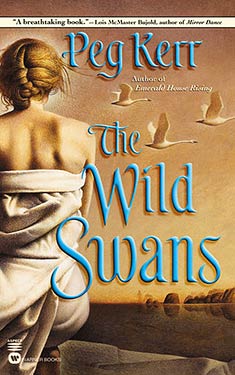Peg Kerr
Completed 6/6/2020,
Reviewed 6/7/2020
5 stars
This was a very difficult book to read, not because of the
writing, but because of the subject matter.
It deals with the AIDS epidemic on a very personal level. It juxtaposes a retelling of Hans Christian
Anderson’s “The Wild Swans” with a tale about a gay young man, kicked out by
his family, and coming out in New York City in the early ‘80s. Having come out myself at about the same
time, I lived through this period.
Reading a book or seeing a film about it is very hard for me and brings
up a lot of anger, terrible sadness, and survivor’s guilt. Nonetheless, I really enjoyed this book, with
the way it told the two stories. Both
stories left me emotionally devastated, but immensely satisfied as well. It was nominated for the Mythopoeic Award and
won the Gaylactic Spectrum Award in 2000.
This first story takes place in the late 1600s. Eliza is the daughter of an earl. Her stepmother has turned her eleven brothers
into swans and gets Eliza banished from court.
She and her brothers go to the New World where she works on breaking the
curse that keeps her brothers as swans by day and humans by night. In alternating chapters, we encounter Elias,
a gay eighteen-year-old, who has been abandoned by his family. He goes to New York where he lives on the
streets. There, he meets Sean who takes
him in, helps him get a job, and shows him gay life in the big city. Elias falls for Sean. But as their relationship develops, their
friends start dying of strange cancers and infections.
The character development is phenomenal. I could identify and empathize with Eliza and
Elias. Elias, of course, was easy,
having been only a few years older than him in the early ‘80s. Eliza, on the other hand, was easy because
Kerr’s writing is so good. I felt
transported back to 17th century England and later Colonial
Massachusetts. The world building was
great. I haven’t read Hans Christian
Anderson’s version of the fairy tale, so I don’t know how much Kerr elaborated
on it, but I felt that the world was rich and realistic. I was also impressed that the other major and
minor characters were just as well rounded.
Nobody felt like a cardboard cutout of a character. Even the evil stepmother felt more three
dimensional than most nemeses.
Reflecting on the story of Elias, his coming out, and his
relationship with Sean in the early days of the AIDS epidemic is difficult for
me. It brings up all sorts of emotions
that I don’t necessarily want to face or feel.
I was glad the book dealt with it in a very matter-of-fact way. It’s easy for a book to get maudlin when
everyone around you is getting sick and dying.
But I felt it wasn’t maudlin at all.
Yet, it still had an emotional punch. I loved Elias and Sean, even
though they were both flawed, Elias in his naivete and Sean in his more cynical
nature. So it is not an easy romantic
story. Their relationship grew over time
and wasn’t immune to rough spots.
My only criticism of the book was how the two stories came
together in the end. It was
simultaneously beautiful and a little forced. I found myself (not so successfully) holding
back the tears with both narratives, but in between my sobs thinking
“Huh?” Of course, it’s the ending, so
going into detail would be a spoiler.
I give this book five stars out of five. Yeah, I cried. I read this book quickly because as it
unfolded, I knew it would get harder and harder to read. The prose was lovely and encouraged my
reading speed. I didn’t feel I missed
out on anything by reading too quickly, except I probably would have cried
earlier in the book if I had allowed myself to read more slowly.

No comments:
Post a Comment